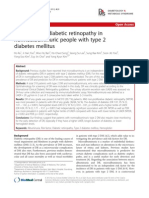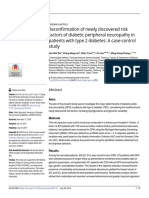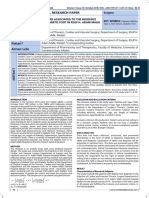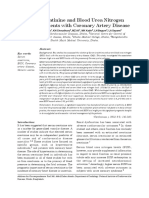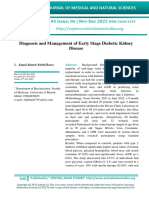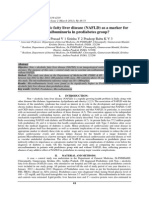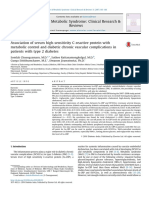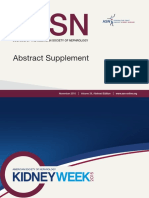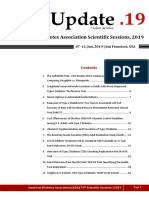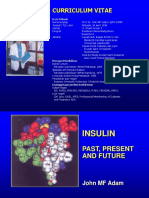Professional Documents
Culture Documents
Effect of Variability of Hemoglobin Value On Type and Severity of Diabetic Retinopathy in Adult Type II Diabetes Mellitus Patients
Original Title
Copyright
Available Formats
Share this document
Did you find this document useful?
Is this content inappropriate?
Report this DocumentCopyright:
Available Formats
Effect of Variability of Hemoglobin Value On Type and Severity of Diabetic Retinopathy in Adult Type II Diabetes Mellitus Patients
Copyright:
Available Formats
Volume 6, Issue 10, October – 2021 International Journal of Innovative Science and Research Technology
ISSN No:-2456-2165
Effect of Variability of Hemoglobin Value on Type
and Severity of Diabetic Retinopathy in Adult
Type II Diabetes Mellitus Patients
Dr. Mehrin Samed1* (correponding author), Dr. Nashwa Abdul Gaffoor2, Dr. Babitha V3, Dr. Padma B Prabhu4
1,2
MBBS-Intern, 3Associate professor, 4Additional professor
1,2,3,4
Govt. Medical College Kozhikode, Kerala, India
Abstract:- I. INTRODUCTION
Background: Anemia has been identified as a risk factor
1
for Diabetic Retinopathy, a leading cause of blindness Diabetic retinopathy (DR), including diabetic
worldwide. However the "at risk" values of hemoglobin maculopathy, is a microvascular complication of DM and
in prognosticating diabetic retinopathy has not been the 2leading cause of blindness worldwide. 3,4,5Various
defined. This study intends to evaluate the relation factors are associated with the development and severity of
between level of hemoglobin and type and severity of DR including high blood pressure, proteinuria, duration of
diabetic retinopathy among type 2 DM. DM, administration of insulin, hyperglycemia and renal
disease. 6,7Anemia is more prevalent in persons with
Methodology: design - descriptive cross sectional study; diabetes. 3Many studies have shown a link between low Hb
duration-6months, study setting- tertiary care hospital in level and hypoxia induced organ damage.
North Kerala, study population- type II DM Patients,
age> 40years with diabetic retinopathy, sample size-87 We designed the study to assess the effect of variation
cases. Variables - gender, age, duration of disease, stages of haemoglobin level on type and severity of diabetic
of Retinopathy, Hb, HbA1C, RFT. p value <0.05 retinopathy and also its association with blood urea, serum
considered as statistically significant. Data analyzed creatinine and Hba1c values.
using chi square and one way anova with PASW
statistics 18.0.0. II. SUBJECTS AND METHODS
Results: Male female ratio=1.2:1. Mean age - 59.83 ± The study was conducted in a tertiary care hospital at
6.201, mean duration of disease- 11.06± 5.564. Mean Hb north Kerala among diabetic retinopathy patients with type
was 11.65 ± 1.89. 81.6% of subjects were anemic. 50.6% II diabetes mellitus and age >40 years having evidence of
subjects had PDR and others had NPDR. 69% of DR on fundus examination. Permission from the
patients had maculopathy. Anemia was more prevalent Institutional Research Committee and Ethical Committee
in PDR patients and those with maculopathy . Among was obtained. There was no financial burden to the study
NPDR and PDR, anemic had severe disease. The mean participants. A descriptive cross sectional study was
Hb values showed a statistically significant relationship conducted for duration of 6 months.
with type and severity of retinopathy irrespective of
gender and nephropathy. Mean Hb and type of A total of 87 cases (based on the formula 4pq/d2,
retinopathy had a statistically significant relationship where p=32, d= 10, p is the prevalence and q=100-p) by
among subjects with poor glycemic control. The lower convenient sampling was taken. DR patients with age of
mean Hb related to male gender and normal HbA1c onset of type II DM <40 years, gestational diabetes,
values among maculopathy cases. pancreatic disease induced diabetes, steroid induced
diabetes, type I diabetes mellitus were excluded.
Conclusion: Lower hemoglobin values correlated with
the severity of diabetic retinopathy and presence of Data about age, gender, duration of type II DM, type
maculopathy independent of gender and presence of of DR, value of hemoglobin, blood urea, serum creatinine,
nephropathy. Correcting anemia and maintaining a Hba1c were collected. Type of retinopathy was classified as
normal Hb value may delay the onset and progression of non proliferative diabetic retinopathy (NPDR) and
diabetic retinopathy and maculopathy in type 2 diabetic proliferative diabetic retinopathy ( PDR). Patients with
adults. NPDR were further grouped according to the severity as
mild, moderate, severe; and PDR as early PDR and high risk
Keywords:- Diabetic Retinopathy, Nephropathy, Anemia, PDR (HRPDR). Patients also evaluated for presence and
Maculopathy. absence of maculopathy. Data was collected using proforma,
lab values from records, and retinal examination. The data
was analysed using chi square test and one way anova. p
value< 0.05 is considered to be statistically significant.
IJISRT21OCT678 www.ijisrt.com 764
Volume 6, Issue 10, October – 2021 International Journal of Innovative Science and Research Technology
ISSN No:-2456-2165
From the data collected the patients were grouped into (NPDR), 18.6% (n=8) had mild, 34.9% (n=15) moderate
anemic and non anemic based on the Hb value. 8In males and 46.5% (n=20) severe NPDR. And among PDR 45.5% (n
Hb<13.5 g/dL (normal Hb value in males =13.5 to 17.5 20) had early PDR, 54.5% (n=24) had high risk PDR
g/dL) and in females Hb<12.0 g/dL (normal value in (HRPDR). 69% (n=60) had evidence of maculopathy.
females=12.0 to 15.5 g/dL) is considered as anaemic.
According to age, patients were divided into 2 groups as <60 Value of Hba1c varied between 4.6 to 14.6% with a
and ≥60 years, data also grouped into two as duration of DM mean of 8.06 ± 1.5 and median eight. Hba1c ≤7%
<10 and ≥10 years. Presence of nephropathy was determined considered as good control of DM. 78.2% (n=68) had poor
with blood urea level 9normal= 7 to 20 mg/dL) and serum short term control of DM. Hemoglobin value ranged from
creatinine level (8normal: males (M) = 0.9 TO 1.3 mg/dL, 8.4 to 15.6 g/dL with a mean of 11.65 ± 1.89 and median
females (F) = 0.6 to 1.1 mg/dL). Patients with blood urea 11.6. Among the subjects 81.6% (n=71) were anemic. The
>20 mg/dL and creatinine >1.3 mg/dL in males and >1.1 minimum blood urea level found in the subjects was
mg/dL in females were considered to have elevated RFT 14mg/dL and maximum 118 mg/dL, with a mean of 34
values. Hba1c values were used to assess whether the ±18.3 and median of 28. In which 86.2% (n=75) had
patient had uncontrolled or controlled DM. 10Hba1c ≤ 7 was elevated blood urea level. The serum creatinine level varied
considered as controlled (short term) diabetes. from 0.6 to 7.1 mg/dL with a mean of 1.42 ± 0.90 and
median equals 1.2. 47.1% (n 41) had high creatinine value.
III. RESULTS Patients with either elevated urea or creatinine were
considered to have nephropathy. Thus 86.2% (n=75) had
The study population included 87 diabetic nephropathy.
subjects. Among them 55.2% were male. The age varied
from 47 to 75 years, mean age was 59.83 ± 6.201 and The distribution of cases based on presence of anemia,
median 60 years. 44.8% were aged < 60yrs. Duration of type type of retinopathy and its severity is given in table-1.
II DM ranged from one year to 25 years with a mean of Presence of anemia showed statistically significant relation
11.06 ± 5.564 and median of ten years. Duration of type II with type of retinopathy (p=0.02) as well as severity of
DM >10yrs in 62.1% (n=54). PDR in 50.6% (n=44). Among NPDR (p=0.017) and severity of PDR (p=0.036).
the subjects with Nonproliferative diabetic retinopathy
Table 1: Relationship between presence of anemia, type of retinopathy and its severity
** p<0.05 (statistically significant)
Presence of anemia and maculopathy was compared. 86.7% (n=52) of patients with maculopathy had anemia while 70.4% (n=19)
Type of retinopathy N Non Anemic Anemic p value
n(%) n(%)
NPDR 43 12(27.9) 31(72.1)
Mild 8 5(62.5) 3(37.5)
0.017**
Moderate 15 5(33.3) 10(66.7)
Severe 20 2(10) 18(90)
PDR 44 4(9.1) 40(90.9)
Early 20 4(20) 16(80)
0.036**
HRPDR 24 0(0) 24(100)
Total 87 16(18.4) 71(81.6) 0.022
of diabetic cases without maculopathy had anemia. Though p value was 0.06, this observation is clinically relevant.
Relation between presence or absence of anemia and normal or abnormal creatinine and urea values is shown in table 2.
54.9% of anemic subjects had high serum creatinine (p=0.02). 87.3% had high urea levels (p=0.384). Presence of anemia did not
show statistically significant correlation with duration of diabetes( p=0.398) or short term glycemic control as evidenced by
HbA1C values ( p=0.093)
IJISRT21OCT678 www.ijisrt.com 765
Volume 6, Issue 10, October – 2021 International Journal of Innovative Science and Research Technology
ISSN No:-2456-2165
Table 2: Relation between presence or absence of anemia and RFT
** p<0.05 (statistically significant)
Serum creatinine Blood urea
n Normal High p n Normal High p
n(%) n(%) n(%) n(%)
Non anemic 16 14 2 16 13 13
(87.5) (12.5) 0.02** (18.8) (81.3) 0.384
Anemic 71 32 39 71 9 62
(45.1) (54.9) (12.7) (87.3)
Based on gender
The subjects were grouped based on gender and Hb Hb value and type of retinopathy based on
values were compared with type of retinopathy using one gender. A statistically significant relation was observed for
way anova. Table 3 and figure 1 represents the relation both males and females with p value 0.003 and 0.001
between respectively.
Figure 1: Relation between Hb value and type of retinopathy based on gender
Table 3: Relation between Hb value and type of retinopathy based on gender
** p<0.05 (statistically significant)
Mean 95% CI
Gender n Hb SD Min Max p
Lower Upper
NPDR 15 11.7 1.26 11.0 12.4 8.8 13.1
F 0.001**
PDR 24 10.3 1.15 9.8 10.7 8.4 12.3
Total 39 10.8 1.35 10.4 11.28 8.4 13.1
NPDR 28 13.0 1.57 13.6 13.6 9.0 15.6
M 0.003**
PDR 20 11.3 2.18 12.3 12.35 8.4 15.1
Total 48 12.3 2.01 12.8 12.89 8.4 15.6
IJISRT21OCT678 www.ijisrt.com 766
Volume 6, Issue 10, October – 2021 International Journal of Innovative Science and Research Technology
ISSN No:-2456-2165
Among those with NPDR, as severity of the disease value was 12.7±2.05, 95% confidence interval =11.31 to
increased Hb value decreased but it was not found to be 14.24 and no extreme values present; for HPDR mean Hb
statistically significant in both genders. Among those with value was 9.88±1.08, 95% confidence interval = 9.10 to
PDR Hb was less when severity of disease increased in both 10.65 with two extreme values. Figure 2 shows a box plot
genders. But the observation was statistically significant representing relation between types of PDR and Hb value in
only in males (p=0.001). In males for early PDR mean Hb males.
Figure 2: Relation between types of PDR and Hb value in males.
Among males, those without maculopathy had a near significant with a p value of 0.007. In females no such
normal mean Hb value (13.43gm%). Those with relation was observed between presence of maculopathy and
maculopathy had a lower mean Hb value of 11.7± 2.07 Hb value. Figure 3 shows a box plot representing the
(95% CI= 10.37 to 11.47). The relation was statistically presence of maculopathy and Hb values in males.
Figure 3: Relation between presence of maculopathy and Hb values in males
IJISRT21OCT678 www.ijisrt.com 767
Volume 6, Issue 10, October – 2021 International Journal of Innovative Science and Research Technology
ISSN No:-2456-2165
Based on variation in serum creatinine values retinopathy. The relation was found to be statistically
Serum creatinine is a more reliable indicator of renal significant in both high and normal creatinine groups with a
function than blood urea nitrogen because it is less p value 0.001 and 0.025 respectively. Table 4 shows an
influenced by diet and hydration. Hence the subjects were analysis between Hb values and type of retinopathy in
grouped based on presence or absence of elevated serum subjects with normal and elevated serum creatinine values.
creatinine and Hb values were compared with type of The same is represented by a box plot in figure 4.
Table 4: Relation between Hb and creatinine value with types of retinopathy
** p<0.05 (statistically significant)
95% CI
Serum creatinine n Mean SD Min Max p
Hb Lower Upper
NPDR 29 12.8 1.48 12.3 13.4 9 15.6
Normal 0.025**
PDR 17 11.7 1.82 10.79 12.6 9.3 15.1
Total 46 12.4 1.69 11.9 12.9 9 15.6
NPDR 14 11.8 1.63 10.9 12.8 8.8 13.3
0.001**
High PDR 27 10.17 1.44 9.5 10.7 8.4 13.9
Total 41 10.7 1.70 10.2 11.2 8.4 13.9
Figure 4: Relation between Hb and creatinine value with types of retinopathy
The subcategories of NPDR and PDR were compared 12.6 ± 1.67 (95% CI 11.4 to 13.8) and for HRPDR was 10.3
with Hb values. Even though the Hb values were less as ± 1.0 (95% CI 9.4 to 11.3). P value was 0.005. Mean Hb of
severity of NPDR increased in both groups no statistically patients with elevated creatinine was lower than those with
significant relation was found. In PDR for both groups, normal values.
mean Hb decreased as disease severity increased, but a
statistically significant relation was found only in patients Hb was lower in patients with maculopathy than
with normal creatinine value not in elevated creatinine without maculopathy in both groups irrespective of presence
value. Among them, the mean Hb value for early PDR was of elevated serum creatinine values. Anemia and presence of
IJISRT21OCT678 www.ijisrt.com 768
Volume 6, Issue 10, October – 2021 International Journal of Innovative Science and Research Technology
ISSN No:-2456-2165
maculopathy showed a significant association in subjects Hb= 12.4± 1.73, 95% CI= 11.4 to 12.7. Figure 5 shows a
with no nephropathy (p 0.022). In this category, patients box plot showing relation between Hb value and presence of
without maculopathy had a mean Hb of 13.2± 1.34, 95% maculopathy in subjects with normal serum creatinine.
CI= 12.5 to 13.94, and for those with maculopathy mean
Figure 5: Relation between Hb value and presence of maculopathy in subjects with normal serum creatinine
Based on diabetic control PDR cases irrespective of the short term glycemic status. A
Subjects were divided on the basis of diabetes control, statistically significant relation was observed among those
and then the relation between Hb level and type of with poor control (table 5, figure 6).
retinopathy assessed. The mean Hb value was less among
Table 5: Relation between Hb and short term glycemic control with type of retinopathy
** p<0.05 (statistically significant)
95% CI
Control of DM n Mean SD Min Max p
Hb
Lower Upper
NPDR 13 12.9 1.5 12.0 13.88 9 15
Controlled 0.108
PDR 6 11.35 2.6 8.5 14.1 8.5 15.1
Total 19 12.4 2.03 11.47 13.4 8.5 15.1
NPDR 30 12.3 1.6 11.7 12.9 8.8 15.6
Uncontrolled 0.001**
PDR 38 10.6 1.6 10.1 11.2 8.4 14.6
Total 68 11.4 1.8 10.98 11.8 8.4 15.6
IJISRT21OCT678 www.ijisrt.com 769
Volume 6, Issue 10, October – 2021 International Journal of Innovative Science and Research Technology
ISSN No:-2456-2165
Figure 6: Relation between type of retinopathy and Hb level in those with uncontrolled diabetes
In the case of NPDR, no relation was found between severity of disease and Hb value. In PDR, both controlled and
uncontrolled DM groups had statistically significant relations (table 6, figure 7).
Table 6: Relation between Hb value and severity of PDR based on short term glycemic control.
** p<0.05 (statistically significant)
95% CI
Control of DM n Mean SD Min Max p
Hb
Lower Upper
Early 2 14.5 0.8 6.8 22.1 13.9 15.1
Controlled 0.011**
HRPDR 4 9.7 1.3 7.6 11.8 8.5 11.6
Total 6 11.3 2.6 8.5 14.1 8.5 15.1
Early 18 11.4 1.7 10.5 12.2 8.6 14.5
Uncontrolled 0.006**
HRPDR 20 10 1.1 9.4 10.5 8.4 12.3
Total 38 10.6 1.6 10.1 11.2 8.4 14.6
IJISRT21OCT678 www.ijisrt.com 770
Volume 6, Issue 10, October – 2021 International Journal of Innovative Science and Research Technology
ISSN No:-2456-2165
Figure 7: Relation between Hb value and severity of PDR based on short term glycemic control.
It was observed that the maculopathy and anemia had value of 13.6 gm% ± 1.23, 95% CI =12.7 to 14.5, and those
a significant relation among the subjects with controlled with maculopathy had a mean Hb value of 11.39 gm% ±
diabetes (p 0.011). Among patients with good short term 2.05, 95% CI= 9.9 to 12.8 ( figure 8)
glycemic control, those with no maculopathy had a mean Hb
Figure 8: Relation between presence of maculopathy and Hb in controlled diabetes patients
IJISRT21OCT678 www.ijisrt.com 771
Volume 6, Issue 10, October – 2021 International Journal of Innovative Science and Research Technology
ISSN No:-2456-2165
IV. DISCUSSION 1.22-2.69) is an independent risk factor for development of
anemia.
Type II Diabetes mellitus is a common disease with an
increased incidence in recent decades. Diabetic retinopathy Anemia was more prevalent in subjects with deranged
(DR), including diabetic maculopathy, is a microvascular RFT values. 13E Ritz and others has noted that anaemia is a
complication of DM and the leading cause of blindness frequent complication of diabetic nephropathy. In diabetic
worldwide. 11The lesions observed in these patients are patients anemia is seen not only in preterminal renal failure,
secondary to microangiopathy and result in increased but also frequently in patients with only minor derangement
vascular permeability in the form of edema. Hypoxia is a of renal function. 14Maurizio Li Vecchi and others mentions
stimulus for the production of erythropoietin (EPO) and for that anemia is more frequent in the diabetic patients with
vascular endothelial growth factor (VEGF). Both EPO and CKD than in the non-diabetic patients with CKD (61.7 vs.
VEGF are neuroprotective factors that possess likely 52%, p < 0.05).
angiogenic potential, leading to an increase in the
proliferation of new retinal vessels and thus inducing the Anemia was more common in subjects with poor
development of proliferative retinopathy. Macular edema diabetic control than that of others. 6Sharif A and others
(ME) may appear at any stage of DR. It is an increase in noticed a higher incidence and risk of anemia poorly
tissue fluid, which causes a thickening of the retina and controlled diabetes (49.5%) compared to those with
secondarily causes structural and functional alterations of controlled diabetes (p < 0.05).
retina. 12Anemia can lead to falsely low HbA1c levels,
which may result in under treatment of hyperglycemia, Among both genders, PDR patients were more anemic
which in turn will contribute to the progression of both than NPDR. In either group, as the disease severity
microvascular and macrovascular diabetic complications. increased the Hb was found to decrease. In the study by
11
The etiology of low hemoglobin (Hb) level in diabetes is Travaset and others, it is observed that Individuals with
multifactorial and includes inflammation, nutritional severe DR showed significantly lower hemoglobin,
deficiencies, renal disease, concomitant autoimmune hematocrit, and erythrocyte levels compared with those with
disease, drugs and hormonal changes. Anemia is associated mild disease. Hemoglobin was the only factor that showed a
with hypoxia. Retinal hypoxia is observed in DR. significant inverse association with the severity of DR [beta-
coefficient = -0.52, P value = 0.003]. 15Irace C Et al found
The study assessed the association of hemoglobin level that Haemoglobin, haematocrit and whole blood viscosity
and diabetic retinopathy among patients with type II DM significantly decreased with increasing severity of
and age more than 40 years. It was found that PDR patients retinopathy.
were more anemic than NPDR. As the hemoglobin level
decreased the disease severity increased. As blood urea can be affected by hydration and diet,
serum creatinine was considered a more reliable parameter
A positive relationship was observed between anemia than blood urea value for determining nephropathy.
and diabetic retinopathy in individuals with type 2 DM. Hemoglobin level in PDR was lower than NPDR
Similar observations were made by 3Chung JO et irrespective of presence of nephropathy. The same was
al. Anemia was prevalent in the majority of the cases. observed in the severity of NPDR and PDR. Among
Anemia causes tissue hypoxia, which is a critical etiology of subjects with PDR, a significant relation occurred only in
diabetic retinopathy. Retinal hypoxia is proposed to case of non nephropathic patients. Thus anemia can be an
stimulate synthesis of vascular endothelial growth factor independent risk factor determining the type and severity of
(VEGF), a strong stimulant of neovascularization. This diabetic retinopathy. 16Wang J and others reports that DKD
factor also increases vascular permeability and retinal severity and anemia had joint effect on NPDR (OR = 2.29,
exudates. Individuals with anemia have been reported to 95% CI = 1.32–3.96) and PDR (OR = 11.31, 95% CI =
have increased systemic levels of VEGF. Therefore, 5.95–21.51). 17according to Lee w j and others proliferative
decreased oxygen delivery due to anemia might have diabetic retinopathy is associated with microalbuminuria
detrimental effects on the retina of individuals with diabetes. and DR is associated with overt nephropathy in DM
Additionally, anemia might contribute to increased oxidative patients.
stress due to a decrease in the absolute number of red blood
cells with antioxidant defense and enhanced free radical In subjects with uncontrolled diabetes mellitus,
production. Irace C and others reported association among hemoglobin was lower in those with PDR than NPDR.
low whole blood viscosity, haematocrit, haemoglobin Among those with poor glycemic control, a lower Hb value
and diabetic retinopathy in subjects with type 2 diabetes. was observed as the disease severity of NPDR and PDR
The author comments that Haemoglobin, haematocrit and increased. Anemia with uncontrolled sugar level may
whole blood viscosity were significantly lower in subjects determine the type and severity of diabetic retinopathy.
18
with retinopathy compared to subjects without retinopathy Chatziralli IP and others have shown that glycemic control
in both gender. A multiple logistic regression analysis remains an important factor for the presence and progression
confirmed the independent inverse association among of DR. HbA1c seems to be an indicator which cannot
viscosity, haematocrit, haemoglobin and retinopathy demonstrate exactly the degree of glycemic control, while
(p<0.01). 12Padmaja Kumari Ranil and others observed that sudden variations of blood glucose may play an important
presence of diabetic retinopathy with OR 1.82 (95% CI
IJISRT21OCT678 www.ijisrt.com 772
Volume 6, Issue 10, October – 2021 International Journal of Innovative Science and Research Technology
ISSN No:-2456-2165
role in DR. Therefore glycemic variability may be useful to REFERENCES
predict DM complications, such as DR.
[1]. Ramanjith Sihota and Radhika Tandon. Parson’s
Subjects with anemia had more risk of developing Diseases of the eye. 23rd edition. Elsevier India 2019.
maculopathy, especially males. According to 11Travaset and [2]. www.who.int
others, lower hemoglobin concentration Is associated with [3]. Chung JO, Park SY, Chung DJ, Chung MY.
retinal ischemia and the severity of Diabetic Retinopathy in Relationship between anemia, serum bilirubin
Type 2 Diabetes. The authors report that hemoglobin concentrations, and diabetic retinopathy in
showed a significant inverse association with retinal individuals with type 2 diabetes. Medicine. 2019
ischemia [beta-coefficient = -0.49, P value = 0.001]. Lower Oct;98(43).
erythrocyte level showed a marginally significant [4]. Bahar A, Kashi Z, Amiri AA, Nabipour M.
association with macular oedema [beta-coefficient = -0.86, P Association between diabetic retinopathy and
value = 0.055]. hemoglobin level. Caspian Journal of Internal
Medicine. 2013;4(4):759.
Anemia and presence of maculopathy showed a [5]. A K Khurana. Comprehensive ophthalmology. 7th
significant association in subjects with no edition. Jaypee Brothers Medical Publishers 2019.
nephropathy. However Hb was lower in patients with [6]. Sharif A, Younus S, Baig K, Ali NH. Prevalence and
maculopathy than without maculopathy in both groups. In risk of anemia in type-2 diabetic patients. Health.
the study conducted by 19Eli A Friedman and others, all 2014 Jun 9;2014
subjects reported subjective improvement in well-being, [7]. Jenchitr W, Samaiporn S, Lertmeemongkolchai P,
including enhanced effort tolerance following an increase in Chongwiriyanurak T, Anujaree P, Chayaboon D,
hematocrit from a baseline level of to 29.6 +/- 2.0% to a Pohikamjorn A. Prevalence of diabetic retinopathy in
level of 39.5 +/- 2.4% after one year of treatment with relation to duration of diabetes mellitus in community
erythropoietin (P = <0.0005). Three patients with macular hospitals of Lampang. J Med Assoc Thai. 2004
edema evinced substantive improvement-based stable vision Nov;87(11):1321-6. PMID: 15825707.
and documented resolution noted in fluorescein. [8]. www.mayoclinic.org
[9]. www.urmc.rochester.edu
It was observed that the maculopathy and anemia had [10]. Damodaran M, Vasudevan and S.
a significant relation among the subjects with controlled Sreekumari.Textbook of Biochemistry for Medical
diabetes. 20Suto C and others, found that the progression rate Students. 9th edition. Jaypee Brothers Medical
of diabetic maculopathy was significantly higher in the Publishers 2019.
group that underwent rapid glycemic control (P = .02). 21S., [11]. Traveset A, Rubinat E, Ortega E, Alcubierre N,
Kajal and others concluded that the stage of diabetic Vazquez B, Hernández M, Jurjo C, Espinet R,
retinopathy rather than metabolic status is a strong Ezpeleta JA, Mauricio D. Lower hemoglobin
predictive factor for the development of diabetic macular concentration is associated with retinal ischemia and
edema. the severity of diabetic retinopathy in type 2 diabetes.
Journal of Diabetes Research. 2016 Apr 20;2016.
Limitations of the study: [12]. Ranil PK, Raman R, Rachepalli SR, Pal SS,
Smaller subgroup population which might have Kulothungan V, Lakshmipathy P, Satagopan U,
affected analysis of secondary objectives because of Covid Kumaramanickavel G, Sharma T. Anemia and diabetic
19 pandemic. Shorter study duration as we did this during retinopathy in type 2 diabetes mellitus. J Assoc
internship. Selection bias and berksonian bias can be there Physicians India. 2010 Feb 1;58:91-4.
because of convenient sampling from hospital visiting [13]. Ritz E, Haxsen V. Diabetic nephropathy and anaemia.
people. Eur J Clin Invest. 2005 Dec;35 Suppl 3:66-74. doi:
10.1111/j.1365-2362.2005.01544.x. PMID: 16281961.
V. CONCLUSION [14]. Li Vecchi M, Fuiano G, Francesco M, Mancuso D,
Faga T, Sponton A, Provenzano R, Andreucci M,
Lower hemoglobin values correlated with the severity Tozzo C. Prevalence and severity of anaemia in
of diabetic retinopathy and presence of maculopathy patients with type 2 diabetic nephropathy and different
independent of gender and presence of nephropathy. degrees of chronic renal insufficiency. Nephron Clin
Correcting anemia and maintaining a normal Hb value may Pract. 2007;105(2):c62-7. doi: 10.1159/000097600.
delay the onset and progression of diabetic retinopathy and Epub 2006 Nov 29. PMID: 17135770.
maculopathy in type 2 diabetic adults. Glycemic control also [15]. Irace C, Scarinci F, Scorcia V, Bruzzichessi D,
has a role in severity and progression of diabetic Fiorentino R, Randazzo G, Scorcia G, Gnasso A.
retinopathy. Rapid glycemic control can worsen Association among low whole blood viscosity,
maculopathy among anemics. haematocrit, haemoglobin and diabetic retinopathy in
subjects with type 2 diabetes. British Journal of
Ophthalmology. 2011 Jan 1;95(1):94-8.
IJISRT21OCT678 www.ijisrt.com 773
Volume 6, Issue 10, October – 2021 International Journal of Innovative Science and Research Technology
ISSN No:-2456-2165
[16]. Wang J, Xin X, Luo W, Wang R, Wang X, Si S, Mo
M, Shao B, Wang S, Shen Y, Chen X, Yu Y. Anemia
and Diabetic Kidney Disease Had Joint Effect on
Diabetic Retinopathy Among Patients With Type 2
Diabetes. Invest Ophthalmol Vis Sci. 2020 Dec
1;61(14):25. doi: 10.1167/iovs.61.14.25. PMID:
33351059; PMCID: PMC7757636.
[17]. Lee WJ, Sobrin L, Lee MJ, Kang MH, Seong M, Cho
H. The relationship between diabetic retinopathy and
diabetic nephropathy in a population-based study in
Korea (KNHANES V-2, 3). Investigative
ophthalmology & visual science. 2014 Oct
1;55(10):6547-53.
[18]. Chatziralli IP. The Role of Glycemic Control and
Variability in Diabetic Retinopathy. Diabetes Ther.
2018 Feb;9(1):431-434. doi: 10.1007/s13300-017-
0345-5. Epub 2017 Nov 30. PMID: 29190012;
PMCID: PMC5801231
[19]. Friedman EA, Francis Jr A, Brown CD, Berman DH.
Treating azotemia-induced anemia with erythropoietin
improves diabetic eye disease: Management of
comorbidities in kidney disease in the 21st century:
Anemia and bone disease. Kidney International. 2003
Nov 1;64:S57-63.
[20]. Suto C, Hori S, Kato S, Muraoka K, Kitano S. Effect
of perioperative glycemic control in progression of
diabetic retinopathy and maculopathy. Arch
Ophthalmol. 2006 Jan;124(1):38-45. doi:
10.1001/archopht.124.1.38. PMID: 16401783.
[21]. S., Kajal, Jayalekshmi T., Manasa S., & Prasenna M..
"Effect of glycemic control on diabetic retinopathy and
diabetic macular edema: a prospective observational
study." International Journal of Advances in Medicine
[Online], 8.2 (2021): 177-182. Web. 8 Jul. 2021
IJISRT21OCT678 www.ijisrt.com 774
You might also like
- PDML Article1Document4 pagesPDML Article1kingdeyNo ratings yet
- JDR2019 7825804Document9 pagesJDR2019 7825804Anonymous Xc7NwZzoNo ratings yet
- Fendo 13 885516Document7 pagesFendo 13 885516adri20121989No ratings yet
- Association of HbA1c Levels and Diabetic Retinopathy SeverityDocument6 pagesAssociation of HbA1c Levels and Diabetic Retinopathy SeverityYoga TDNo ratings yet
- Predictors For Diabetic Retinopathy in Normoalbuminuric People With Type 2 Diabetes MellitusDocument6 pagesPredictors For Diabetic Retinopathy in Normoalbuminuric People With Type 2 Diabetes MellitusdrheriNo ratings yet
- Jurnal AnemiaDocument4 pagesJurnal AnemiaAchmad Aidil TazakkaNo ratings yet
- Anemia JournalDocument5 pagesAnemia JournalKalyani SanthoshNo ratings yet
- Dialysis Induced Hypoglycemia in Non-Diabetic Chronic Kidney Disease PatientsDocument3 pagesDialysis Induced Hypoglycemia in Non-Diabetic Chronic Kidney Disease Patientsscience worldNo ratings yet
- 2016 Article 69Document10 pages2016 Article 69Rhowy Al-mu'izzahNo ratings yet
- Reconfirmation of Newly Discovered Risk Factors of Diabetic Peripheral Neuropathy in Patients With Type 2 Diabetes: A Case-Control StudyDocument10 pagesReconfirmation of Newly Discovered Risk Factors of Diabetic Peripheral Neuropathy in Patients With Type 2 Diabetes: A Case-Control Studychrisna dewiNo ratings yet
- A Prospective Evaluation of Microvascular ComplicaDocument5 pagesA Prospective Evaluation of Microvascular ComplicaBeatrizNo ratings yet
- Correlation of Duration Hypertension and GlycemicDocument5 pagesCorrelation of Duration Hypertension and GlycemicDIBA TRIULANDARI KUSNADINo ratings yet
- The Prevalence of Resistant Hypertension Among TypDocument7 pagesThe Prevalence of Resistant Hypertension Among TypProfessor Kamel AjlouniNo ratings yet
- 28xlekosit Between Diabetes Complications LekositDocument5 pages28xlekosit Between Diabetes Complications LekositHoopmen tampubolonNo ratings yet
- Austin Journal of Nephrology and HypertensionDocument4 pagesAustin Journal of Nephrology and HypertensionAustin Publishing GroupNo ratings yet
- Risk factors for diabetic foot in IndonesiaDocument4 pagesRisk factors for diabetic foot in IndonesiaFernando SilalahiNo ratings yet
- Journal Pre-Proofs: Diabetes Research and Clinical PracticeDocument15 pagesJournal Pre-Proofs: Diabetes Research and Clinical PracticeqalbiNo ratings yet
- Prevalence of Anemia in Patients With Type 2 Diabetes Mellitus at Gandhinagar, Gujarat, IndiaDocument5 pagesPrevalence of Anemia in Patients With Type 2 Diabetes Mellitus at Gandhinagar, Gujarat, Indiaayham luNo ratings yet
- Serum Creatinine and Blood Urea Nitrogen Levels in Patients With Coronary Artery DiseaseDocument5 pagesSerum Creatinine and Blood Urea Nitrogen Levels in Patients With Coronary Artery DiseaseUswatun HasanahNo ratings yet
- 1 s2.0 S1658361211701731 Main PDFDocument11 pages1 s2.0 S1658361211701731 Main PDFMakmur SejatiNo ratings yet
- 302 Cardiovascular Risk: AssessmentDocument1 page302 Cardiovascular Risk: AssessmentLêHữuHoàiNo ratings yet
- Prevalence and Major Risk Factors of Diabetic Retinopathy: A Cross-Sectional Study in EcuadorDocument5 pagesPrevalence and Major Risk Factors of Diabetic Retinopathy: A Cross-Sectional Study in EcuadorJorge Andres Talledo DelgadoNo ratings yet
- The Prevalence and Risk Factors Associated With Type 2 Diabetic Retinopathy in RwandaDocument9 pagesThe Prevalence and Risk Factors Associated With Type 2 Diabetic Retinopathy in RwandaIJAR JOURNALNo ratings yet
- Jurnal Neuropati 10Document5 pagesJurnal Neuropati 10julia putriNo ratings yet
- MPV as a Predictor of Retinopathy in DiabetesDocument12 pagesMPV as a Predictor of Retinopathy in DiabetesHamid IqbalNo ratings yet
- Jurnal PH 13Document9 pagesJurnal PH 13ruthameliapNo ratings yet
- Diagnosis and Management of Early Stage Diabetic Kidney DiseaseDocument11 pagesDiagnosis and Management of Early Stage Diabetic Kidney DiseaseCentral Asian StudiesNo ratings yet
- Hypoglycemia in Emergency Department: Journal of Acute DiseaseDocument4 pagesHypoglycemia in Emergency Department: Journal of Acute DiseaseMahdaNo ratings yet
- NAFLD and microalbuminuria in prediabetesDocument4 pagesNAFLD and microalbuminuria in prediabetesBinaNuraeniNo ratings yet
- HbA1c and Serum Lipid Correlation with Diabetic Retinopathy SeverityDocument7 pagesHbA1c and Serum Lipid Correlation with Diabetic Retinopathy SeveritycjristinNo ratings yet
- DM 2Document3 pagesDM 2Clararida RiawanNo ratings yet
- Development and Validation of A Risk Prediction Model For End-Stage Renal Disease in Patients With Type 2 DiabetesDocument13 pagesDevelopment and Validation of A Risk Prediction Model For End-Stage Renal Disease in Patients With Type 2 DiabetesMarta CarolNo ratings yet
- Adipocyte Fatty Acid Binding Protein (A-Fabp) As A Novel Biochemical Marker of Diabetic RetinopathyDocument11 pagesAdipocyte Fatty Acid Binding Protein (A-Fabp) As A Novel Biochemical Marker of Diabetic RetinopathyIJAR JOURNALNo ratings yet
- Study of Hemotologicalprofile and Serum Iron Indices in Chronic Kidney Disease in Tertiary Care CentreDocument5 pagesStudy of Hemotologicalprofile and Serum Iron Indices in Chronic Kidney Disease in Tertiary Care CentreIJAR JOURNALNo ratings yet
- Vascular Endothelial Growth Factor Gene Insertion or Deletion Polymorphism and DiabeticDocument7 pagesVascular Endothelial Growth Factor Gene Insertion or Deletion Polymorphism and DiabeticIdham Adyasa Manggala PutraNo ratings yet
- Kocyigit 2012Document8 pagesKocyigit 2012Rengganis PutriNo ratings yet
- 2017 - Bansal - Corelation of HbA1c Levels and Duration of Diabetes With PADDocument4 pages2017 - Bansal - Corelation of HbA1c Levels and Duration of Diabetes With PADbuat nugas28No ratings yet
- Variability in The Control of Type 2 Diabetes in Primary Care and Its Association With Hospital Admissions For Vascular Events. The APNA Study.Document12 pagesVariability in The Control of Type 2 Diabetes in Primary Care and Its Association With Hospital Admissions For Vascular Events. The APNA Study.franciscoNo ratings yet
- Baca IniDocument9 pagesBaca IniRahmi Annisa MaharaniNo ratings yet
- Mean Platelet Volume To Lymphocyte Ratio As A Novel Marker For Diabetic NephropathyDocument4 pagesMean Platelet Volume To Lymphocyte Ratio As A Novel Marker For Diabetic NephropathyNurlinaNo ratings yet
- Ijcem 0037903Document5 pagesIjcem 0037903riyanNo ratings yet
- The Saudi Diabetic Kidney Disease StudyDocument11 pagesThe Saudi Diabetic Kidney Disease StudyVanroNo ratings yet
- (2016) HSCRP With DMDocument6 pages(2016) HSCRP With DMadri20121989No ratings yet
- Clinical Course of Diabetic Ketoacidosis in Hypertriglyceridemic Pancreatitis Pancreas 2015Document4 pagesClinical Course of Diabetic Ketoacidosis in Hypertriglyceridemic Pancreatitis Pancreas 2015América FloresNo ratings yet
- Serial Measurement of Lipid Profile in Patients With Acute Myocardial InfarctionDocument4 pagesSerial Measurement of Lipid Profile in Patients With Acute Myocardial InfarctionMJSPNo ratings yet
- Frequency of Peripheral Neuropathy Among Patients of Type 2 Diabetes Mellitus by Using The Michigan Neuropathy Screening InstrumentDocument5 pagesFrequency of Peripheral Neuropathy Among Patients of Type 2 Diabetes Mellitus by Using The Michigan Neuropathy Screening InstrumentMedERA JCMHLMCNo ratings yet
- Relationship Between Malnutrition-Inflammation Complex Syndrome and Fluid Balance in Maintenance Hemodialysis PatientsDocument8 pagesRelationship Between Malnutrition-Inflammation Complex Syndrome and Fluid Balance in Maintenance Hemodialysis PatientsMaricic MilovanNo ratings yet
- Mertoglu and Gunay 2017Document5 pagesMertoglu and Gunay 2017Via MeysaNo ratings yet
- 2021 Journal of Personalized Medicine. 11 (8) 799Document14 pages2021 Journal of Personalized Medicine. 11 (8) 799Sofa ChaNo ratings yet
- 313-Article Text-887-1-10-20180209Document7 pages313-Article Text-887-1-10-20180209stoicea catalinNo ratings yet
- Chronic Kidney Disease : Hypertensive and Diabetic Retinopathy in PatientsDocument7 pagesChronic Kidney Disease : Hypertensive and Diabetic Retinopathy in PatientsAnonymous FgT04krgymNo ratings yet
- 2011 - Denicola (Jurnal)Document9 pages2011 - Denicola (Jurnal)Riana HandayaniNo ratings yet
- Prevalence of Metabolic Syndrome in Patients With Psoriasis: A Hospital-Based Cross-Sectional StudyDocument6 pagesPrevalence of Metabolic Syndrome in Patients With Psoriasis: A Hospital-Based Cross-Sectional StudyAdel Ciiy OcheNo ratings yet
- Makale Neo-Adma - Eng V2Document12 pagesMakale Neo-Adma - Eng V2Thomas LeonNo ratings yet
- Hypertension ThesisDocument31 pagesHypertension ThesisNavin AdhikariNo ratings yet
- Diabetes & Metabolic Syndrome: Clinical Research & ReviewsDocument6 pagesDiabetes & Metabolic Syndrome: Clinical Research & ReviewsRizki NovNo ratings yet
- Diabetes & Metabolic Syndrome: Clinical Research & ReviewsDocument6 pagesDiabetes & Metabolic Syndrome: Clinical Research & ReviewsRizki NovNo ratings yet
- ncbiDocument10 pagesncbiFebby AuliaNo ratings yet
- Neutrophil To Lymphocyte and Platelet To LymphocytDocument7 pagesNeutrophil To Lymphocyte and Platelet To LymphocytpriyaNo ratings yet
- Diabetic Retinopathy: Introduction to Novel Treatment StrategiesFrom EverandDiabetic Retinopathy: Introduction to Novel Treatment StrategiesNo ratings yet
- Adoption of International Public Sector Accounting Standards and Quality of Financial Reporting in National Government Agricultural Sector Entities, KenyaDocument12 pagesAdoption of International Public Sector Accounting Standards and Quality of Financial Reporting in National Government Agricultural Sector Entities, KenyaInternational Journal of Innovative Science and Research TechnologyNo ratings yet
- Analysis of Financial Ratios that Relate to Market Value of Listed Companies that have Announced the Results of their Sustainable Stock Assessment, SET ESG Ratings 2023Document10 pagesAnalysis of Financial Ratios that Relate to Market Value of Listed Companies that have Announced the Results of their Sustainable Stock Assessment, SET ESG Ratings 2023International Journal of Innovative Science and Research TechnologyNo ratings yet
- A Curious Case of QuadriplegiaDocument4 pagesA Curious Case of QuadriplegiaInternational Journal of Innovative Science and Research TechnologyNo ratings yet
- Forensic Evidence Management Using Blockchain TechnologyDocument6 pagesForensic Evidence Management Using Blockchain TechnologyInternational Journal of Innovative Science and Research TechnologyNo ratings yet
- Improvement Functional Capacity In Adult After Percutaneous ASD ClosureDocument7 pagesImprovement Functional Capacity In Adult After Percutaneous ASD ClosureInternational Journal of Innovative Science and Research TechnologyNo ratings yet
- Fruit of the Pomegranate (Punica granatum) Plant: Nutrients, Phytochemical Composition and Antioxidant Activity of Fresh and Dried FruitsDocument6 pagesFruit of the Pomegranate (Punica granatum) Plant: Nutrients, Phytochemical Composition and Antioxidant Activity of Fresh and Dried FruitsInternational Journal of Innovative Science and Research TechnologyNo ratings yet
- Pdf to Voice by Using Deep LearningDocument5 pagesPdf to Voice by Using Deep LearningInternational Journal of Innovative Science and Research TechnologyNo ratings yet
- Machine Learning and Big Data Analytics for Precision Cardiac RiskStratification and Heart DiseasesDocument6 pagesMachine Learning and Big Data Analytics for Precision Cardiac RiskStratification and Heart DiseasesInternational Journal of Innovative Science and Research TechnologyNo ratings yet
- Late Presentation of Pulmonary Hypertension Crisis Concurrent with Atrial Arrhythmia after Atrial Septal Defect Device ClosureDocument12 pagesLate Presentation of Pulmonary Hypertension Crisis Concurrent with Atrial Arrhythmia after Atrial Septal Defect Device ClosureInternational Journal of Innovative Science and Research TechnologyNo ratings yet
- Severe Residual Pulmonary Stenosis after Surgical Repair of Tetralogy of Fallot: What’s Our Next Strategy?Document11 pagesSevere Residual Pulmonary Stenosis after Surgical Repair of Tetralogy of Fallot: What’s Our Next Strategy?International Journal of Innovative Science and Research TechnologyNo ratings yet
- Food habits and food inflation in the US and India; An experience in Covid-19 pandemicDocument3 pagesFood habits and food inflation in the US and India; An experience in Covid-19 pandemicInternational Journal of Innovative Science and Research TechnologyNo ratings yet
- The Students’ Assessment of Family Influences on their Academic MotivationDocument8 pagesThe Students’ Assessment of Family Influences on their Academic MotivationInternational Journal of Innovative Science and Research Technology100% (1)
- Scrolls, Likes, and Filters: The New Age Factor Causing Body Image IssuesDocument6 pagesScrolls, Likes, and Filters: The New Age Factor Causing Body Image IssuesInternational Journal of Innovative Science and Research TechnologyNo ratings yet
- Optimization of Process Parameters for Turning Operation on D3 Die SteelDocument4 pagesOptimization of Process Parameters for Turning Operation on D3 Die SteelInternational Journal of Innovative Science and Research TechnologyNo ratings yet
- Design and Implementation of Homemade Food Delivery Mobile Application Using Flutter-FlowDocument7 pagesDesign and Implementation of Homemade Food Delivery Mobile Application Using Flutter-FlowInternational Journal of Innovative Science and Research TechnologyNo ratings yet
- Blockchain-Enabled Security Solutions for Medical Device Integrity and Provenance in Cloud EnvironmentsDocument13 pagesBlockchain-Enabled Security Solutions for Medical Device Integrity and Provenance in Cloud EnvironmentsInternational Journal of Innovative Science and Research TechnologyNo ratings yet
- Investigating the Impact of the Central Agricultural Research Institute's (CARI) Agricultural Extension Services on the Productivity and Livelihoods of Farmers in Bong County, Liberia, from 2013 to 2017Document12 pagesInvestigating the Impact of the Central Agricultural Research Institute's (CARI) Agricultural Extension Services on the Productivity and Livelihoods of Farmers in Bong County, Liberia, from 2013 to 2017International Journal of Innovative Science and Research TechnologyNo ratings yet
- Optimizing Sound Quality and Immersion of a Proposed Cinema in Victoria Island, NigeriaDocument4 pagesOptimizing Sound Quality and Immersion of a Proposed Cinema in Victoria Island, NigeriaInternational Journal of Innovative Science and Research TechnologyNo ratings yet
- Enhancing Biometric Attendance Systems for Educational InstitutionsDocument7 pagesEnhancing Biometric Attendance Systems for Educational InstitutionsInternational Journal of Innovative Science and Research TechnologyNo ratings yet
- The Experiences of Non-PE Teachers in Teaching First Aid and Emergency Response: A Phenomenological StudyDocument89 pagesThe Experiences of Non-PE Teachers in Teaching First Aid and Emergency Response: A Phenomenological StudyInternational Journal of Innovative Science and Research TechnologyNo ratings yet
- Development of a Local Government Service Delivery Framework in Zambia: A Case of the Lusaka City Council, Ndola City Council and Kafue Town Council Roads and Storm Drain DepartmentDocument13 pagesDevelopment of a Local Government Service Delivery Framework in Zambia: A Case of the Lusaka City Council, Ndola City Council and Kafue Town Council Roads and Storm Drain DepartmentInternational Journal of Innovative Science and Research TechnologyNo ratings yet
- Targeted Drug Delivery through the Synthesis of Magnetite Nanoparticle by Co-Precipitation Method and Creating a Silica Coating on itDocument6 pagesTargeted Drug Delivery through the Synthesis of Magnetite Nanoparticle by Co-Precipitation Method and Creating a Silica Coating on itInternational Journal of Innovative Science and Research TechnologyNo ratings yet
- Databricks- Data Intelligence Platform for Advanced Data ArchitectureDocument5 pagesDatabricks- Data Intelligence Platform for Advanced Data ArchitectureInternational Journal of Innovative Science and Research TechnologyNo ratings yet
- Design and Development of Controller for Electric VehicleDocument4 pagesDesign and Development of Controller for Electric VehicleInternational Journal of Innovative Science and Research TechnologyNo ratings yet
- Quality By Plan Approach-To Explanatory Strategy ApprovalDocument4 pagesQuality By Plan Approach-To Explanatory Strategy ApprovalInternational Journal of Innovative Science and Research TechnologyNo ratings yet
- A Review on Process Parameter Optimization in Material Extrusion Additive Manufacturing using ThermoplasticDocument4 pagesA Review on Process Parameter Optimization in Material Extrusion Additive Manufacturing using ThermoplasticInternational Journal of Innovative Science and Research TechnologyNo ratings yet
- Digital Pathways to Empowerment: Unraveling Women's Journeys in Atmanirbhar Bharat through ICT - A Qualitative ExplorationDocument7 pagesDigital Pathways to Empowerment: Unraveling Women's Journeys in Atmanirbhar Bharat through ICT - A Qualitative ExplorationInternational Journal of Innovative Science and Research TechnologyNo ratings yet
- Gardening Business System Using CNN – With Plant Recognition FeatureDocument4 pagesGardening Business System Using CNN – With Plant Recognition FeatureInternational Journal of Innovative Science and Research TechnologyNo ratings yet
- Anxiety, Stress and Depression in Overseas Medical Students and its Associated Factors: A Descriptive Cross-Sectional Study at Jalalabad State University, Jalalabad, KyrgyzstanDocument7 pagesAnxiety, Stress and Depression in Overseas Medical Students and its Associated Factors: A Descriptive Cross-Sectional Study at Jalalabad State University, Jalalabad, KyrgyzstanInternational Journal of Innovative Science and Research Technology90% (10)
- Comparison of Lateral Cephalograms with Photographs for Assessing Anterior Malar Prominence in Maharashtrian PopulationDocument8 pagesComparison of Lateral Cephalograms with Photographs for Assessing Anterior Malar Prominence in Maharashtrian PopulationInternational Journal of Innovative Science and Research TechnologyNo ratings yet
- Chlorpropamide: Drug Information: Brand Names: CanadaDocument13 pagesChlorpropamide: Drug Information: Brand Names: CanadaAnonymous wmF9p2ejNo ratings yet
- Tirzepatide Significantly Reduced A1C and Body Weight in People With Type 2 Diabetes in Two Phase 3 Trials From Lilly's SURPASS ProgramDocument4 pagesTirzepatide Significantly Reduced A1C and Body Weight in People With Type 2 Diabetes in Two Phase 3 Trials From Lilly's SURPASS ProgramJOSÉ CARLOS ÁLVAREZ PAYARESNo ratings yet
- Chapter 17 - Diabetes Mellitus: The Two Key TasksDocument20 pagesChapter 17 - Diabetes Mellitus: The Two Key Tasksprofarmah6150No ratings yet
- Glycemic Control (3) - 1Document17 pagesGlycemic Control (3) - 1robert mbwamboNo ratings yet
- KW 15 AbstractsDocument1,129 pagesKW 15 AbstractsShloime-Batsheva Dalezman100% (1)
- Periodontal Medicine - SLIDEDocument34 pagesPeriodontal Medicine - SLIDENada R. AbukhalafNo ratings yet
- Health Benifits of Kalonji Oil - SrushtiDocument8 pagesHealth Benifits of Kalonji Oil - SrushtiVilash ShingareNo ratings yet
- Scott 2015Document20 pagesScott 2015Raíla SoaresNo ratings yet
- 79th American Diabetes Association Scientific Sessions - ADA Update 2019 PDFDocument44 pages79th American Diabetes Association Scientific Sessions - ADA Update 2019 PDFAmit BhondveNo ratings yet
- Managing Diabetes in HospitalsDocument9 pagesManaging Diabetes in HospitalsJharaNo ratings yet
- Practical Guide To Diabetes Management in RamadhanDocument44 pagesPractical Guide To Diabetes Management in Ramadhanumiraihana1100% (1)
- INSULINDocument6 pagesINSULINmilaNo ratings yet
- Guias DIABETES CARE 2021Document244 pagesGuias DIABETES CARE 2021johnbravo777No ratings yet
- Preoperative Evaluation Guide for SurgeonsDocument65 pagesPreoperative Evaluation Guide for Surgeonsdr_trialNo ratings yet
- Product Quality ReviewDocument46 pagesProduct Quality Reviewjibran khanNo ratings yet
- Manila Tamarind For Diabetic J.eujim.2015.01.001Document31 pagesManila Tamarind For Diabetic J.eujim.2015.01.001Nageshwaran VairavasamyNo ratings yet
- Perioperative Management of Blood Glucose in Adults With Diabetes Mellitus - UpToDateDocument18 pagesPerioperative Management of Blood Glucose in Adults With Diabetes Mellitus - UpToDateNayeli Chora100% (1)
- Portion AR For Diabetes MellitusDocument9 pagesPortion AR For Diabetes Mellitusfarah paramitaNo ratings yet
- Bitter GourdDocument7 pagesBitter GourdmarianaivanovaprofNo ratings yet
- NIH Public Access: The Role of Hyperglycemia in Burned Patients: Evidence-Based StudiesDocument21 pagesNIH Public Access: The Role of Hyperglycemia in Burned Patients: Evidence-Based StudiesMuhammad Hadyan RusinNo ratings yet
- REVIEW JURNAL DM Kelompok 4Document68 pagesREVIEW JURNAL DM Kelompok 4Ratu AnandaNo ratings yet
- Case Study DM 2 PWDTDocument8 pagesCase Study DM 2 PWDTsantis_8No ratings yet
- Initial Management of Blood Glucose in Adults With Type 2 Diabetes Mellitus - UpToDateDocument24 pagesInitial Management of Blood Glucose in Adults With Type 2 Diabetes Mellitus - UpToDateJessica ArciniegasNo ratings yet
- (Part 5) Fundamentals of Nursing Pre BoardDocument30 pages(Part 5) Fundamentals of Nursing Pre BoardJhaylord mendoza100% (1)
- Devitt AA Et Al. J Diabetes Res Clin Metab. 2012 1 20Document9 pagesDevitt AA Et Al. J Diabetes Res Clin Metab. 2012 1 20Teresa100% (1)
- Clinicians Handbook of DiabetesDocument227 pagesClinicians Handbook of DiabetesAndra PetroiuNo ratings yet
- Qtern 84413Document19 pagesQtern 84413Manoj KaluvakotaNo ratings yet
- CURRICULUM VITAE AND HISTORY OF INSULINDocument45 pagesCURRICULUM VITAE AND HISTORY OF INSULINDian SobaNo ratings yet
- 2022 Diabetes Secrets by Michael T. McDermottDocument200 pages2022 Diabetes Secrets by Michael T. McDermottPeter Albeiro Falla Cortes100% (4)
- CAROLINA TrialDocument12 pagesCAROLINA TrialsaurabhNo ratings yet




